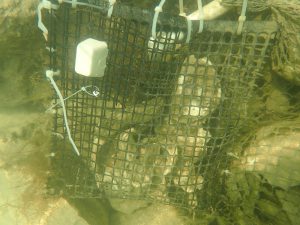NCBS Intern Report by Cher Nicholson, Intern with UF IFAS Nature Coast Biological Station’s Dr. Savanna Barry, Brittany Scharf and Josh Patterson
 Did you kayak to work this week? On a special day during my summer internship with Nature Coast Biological Station working on the Centipede Bay Oyster and Marsh Habitat Enhancement Project, I was able to kayak to work! Brittany Scharf and I were able to kayak out to the artificial oyster reef we helped construct in April to do monthly monitoring and to put out clod cards as a part of my experiment. Looking at the unique shape of the reef and how water moves in that location, I wanted to have a better understanding of the different relative flow intensities at seven different sites. Clod cards are cubes made of hardened Plaster of Paris and were used on the reef to calculate the relative flow intensity of the water based off the amount of dissolution of the cubes. The relative flow intensity of each site can be calculated according to Thompson and Glenn (1994). With the use of their equation, the flow intensity can be calculated by plugging in the values for the clod card calibration, which accounts for dissolution of the cubes due to being submerged in the water alone, and the change in mass of the cubes once exposed to moving water for three days. This method provided a cost-effective way to demonstrate the relative flow of water within channels and on the reef.
Did you kayak to work this week? On a special day during my summer internship with Nature Coast Biological Station working on the Centipede Bay Oyster and Marsh Habitat Enhancement Project, I was able to kayak to work! Brittany Scharf and I were able to kayak out to the artificial oyster reef we helped construct in April to do monthly monitoring and to put out clod cards as a part of my experiment. Looking at the unique shape of the reef and how water moves in that location, I wanted to have a better understanding of the different relative flow intensities at seven different sites. Clod cards are cubes made of hardened Plaster of Paris and were used on the reef to calculate the relative flow intensity of the water based off the amount of dissolution of the cubes. The relative flow intensity of each site can be calculated according to Thompson and Glenn (1994). With the use of their equation, the flow intensity can be calculated by plugging in the values for the clod card calibration, which accounts for dissolution of the cubes due to being submerged in the water alone, and the change in mass of the cubes once exposed to moving water for three days. This method provided a cost-effective way to demonstrate the relative flow of water within channels and on the reef.
 A Closer Look…
A Closer Look…
Initially, I hoped to compare the relative flow intensity at each of the seven chosen sites with recruitment data from settling oyster spat, but with the vast amount of sediment that accumulated on the shells there was no recruitment recorded for the summer spawning season. Instead of looking at recruitment, I shifted my study to analyze the problem of sedimentation. I hope to investigate the possible correlation of relative flow intensity of the water and sedimentation at each site.
 The Process
The Process
The cause of sedimentation on the reef was in question, so I got the opportunity to drive a boat out to the reef site with Dr. Patterson to clean off four bags from each of the seven sites using a water pump that blasted sea water out like a fire hose! After, four cleaned bags and four untouched bags were placed interchangeably in a row of eight at each site.

Photos were taken of each bag (56) after the cleaning and a month later. After analyzing these photos for percent coverage of sediment on the reef, I hope to understand how these data relate to the relative flow intensity at each site.
 My Experience of a Lifetime
My Experience of a Lifetime
I am very grateful for the opportunity to conduct my own study and go beyond the job description of my intern position with NCBS. Within the internship itself, I gained valuable experience in field work, learned how to construct project materials, and monitored marsh grasses planted at Linda Pedersen Park and those at the nursery in Gulf Coast Academy in Hernando County, FL. I was even able to assist Dr. Barry during the Master Naturalist Course in Cedar Key earlier this summer and gave a presentation on oyster restoration to the group. I am very thankful for my summer spent as an NCBS intern and my time spent in Hernando County.
 0
0
